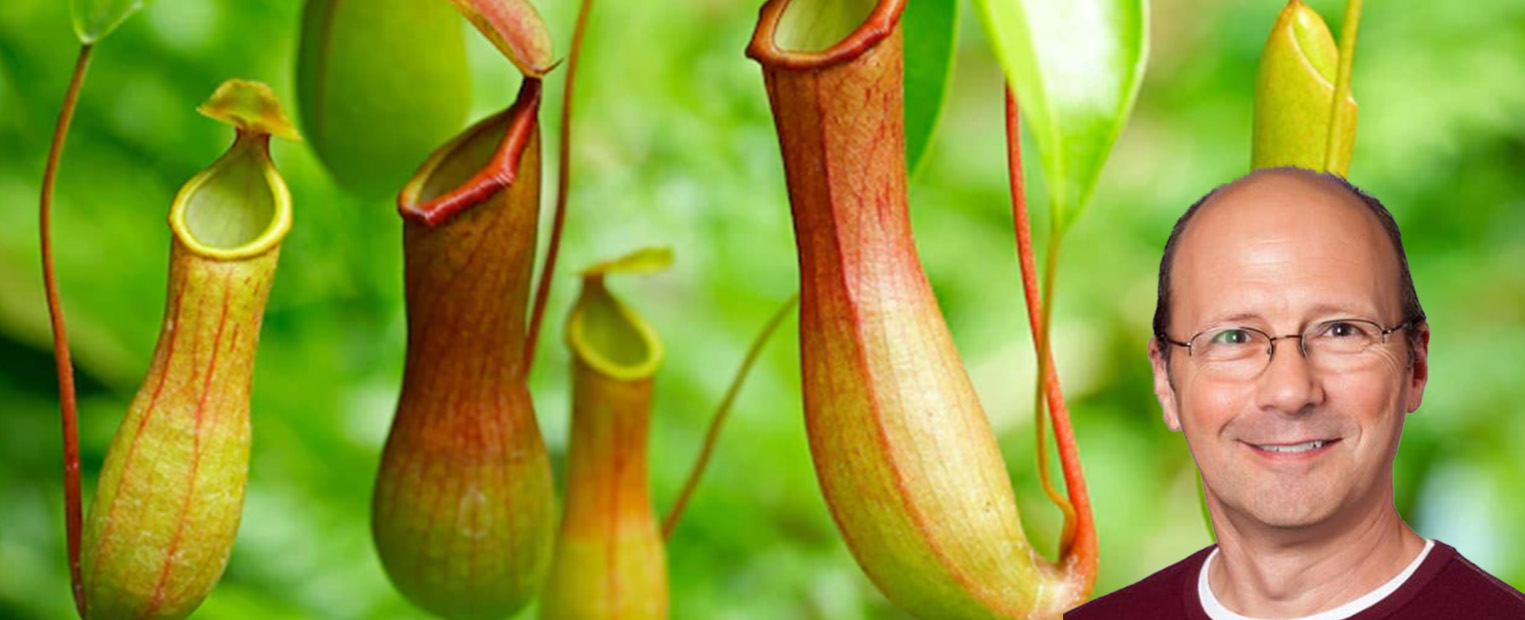Carnivorous plants have a wild array of adaptations that help them flourish in nutrient-poor environments, which include strategies to lure prey to their traps. The most well-known carnivorous plant, the Venus flytrap, is not found in Texas. These plants are found only in North and South Carolina. Four of the five types of carnivorous plants can be found in North America and include pitcher plants, sundews, bladderworts, and butterworts. John Horner, TCU biology professor, is an evolutionary ecologist with research interests in plant-insect interactions. Here he answers some in-depth questions about these fascinating plants.
What is a pitcher plant, and where can they be found?
Pitcher plants are carnivorous plants with leaves in the form of funnels or trumpets. These leaves serve as pitfall traps for hapless prey, usually insects, but sometimes frogs, lizards, or birds. Like all carnivorous plants, pitcher plants live in nutrient-poor wetlands. In the United States, various species occur in all southern states from Texas to Florida, along the east coast, and in northern states from Minnesota to Maine. There’s also a species that occurs in California, Oregon, and Washington.
What are some of the differing methods of capture employed by carnivorous plants?
Prey capture allows carnivorous plants to supplement the nutrients that they can acquire from their abiotic environment. There are well over 600 species of carnivorous plants, and they have evolved a number of mechanisms for prey capture. Some, like pitcher plants, use pitfall traps. This is aided by the nectar around the lip, which in many species is slippery, causing insects to lose their footing. One species of pitcher plant has evolved a “spring board” that launches prey items into the trap. Another mechanism of prey capture is the well-known snap trap of the Venus fly trap. There are many species that use “sticky traps” or “flypaper traps.” These have a sticky mucilage on the tips of fine hairs that entangle insects that land on them. A large number of aquatic species use suction traps. When a trigger is touched, a spring door snaps inward into a pot-like structure. This sucks an invertebrate into the trap, where the prey item is digested. Still other aquatic species use “lobster pot” traps. Prey find their way into the traps but have difficulty finding their way out.
How are carnivorous plants able to attract prey?
Prey attraction varies among species. Pitcher plants attract prey with nectar, which in most species is concentrated around the “lip” of the funnel. Pitcher plants and other carnivorous plants also use odors and contrasting color patterns to lure their prey.
How are plants able to digest the insects they capture?
The digestion of prey varies among the many species. Some produce enzymes that digest the captured prey. Others depend on commensals or mutualists, much like humans depend on gut microorganisms. For example, some pitcher plants do not produce enzymes to allow them to digest prey. Instead, insect larvae and various other invertebrates and bacteria that live in the pitcher will feed on the captured prey, breaking them into smaller bits and nutritious compounds that the plants then absorb.
What other symbiotic relationships do carnivorous plants form other than with insects?
Carnivorous plants interact with a large number of organisms. Although carnivorous plants have evolved the ability to capture and digest insects, they also have natural enemies. There are a number of insect species that specialize on feeding on different parts of carnivorous plants, including the traps. Also, there are a number of insect larvae, other invertebrates, and bacteria that inhabit the traps of pitcher plants. They form small communities of consumers that feed on captured prey. Most carnivorous plants are also dependent on insect pollinators to deliver pollen from one plant to another. They’ve evolved a number of mechanisms to avoid trapping their pollinators, such as flowers and traps being produced at different times of the growing season. Because of the richness of their interactions, carnivorous plants are a fascinating group of organisms to examine for both researchers and laypersons.
What does the study of carnivorous plants tell us about the ecology and evolution of the environment?
Carnivorous plants live in nutrient-poor wetlands. These habitats, and pitcher plants themselves, support a wide variety of organisms. These habitats are being lost at an alarming rate due to land-use changes and human encroachment. As a result, the rate of loss of these habitats is an index of the loss of natural habitat and biodiversity in general. The organisms that live in these habitats are also very sensitive to environmental pollution. Therefore, their populations can reveal pollution, even in its early stages.
The study of the evolution of carnivorous plants reveals some amazing aspects of evolution. For example, carnivory in plants has evolved independently at least six times, an amazing example of convergent evolution. The study of their traps (which are usually modified from leaves) reveals how simple mutations can lead to leaves of vastly different shapes. They also serve as great examples of heritable traits that get re-purposed. For example, the hairs on sticky traps originally evolved as a defense against insects feeding on them. These hairs were re-purposed to “turn the tables” and capture and digest insects that came to feed on them. Carnivorous plants also reveal how turning on genes in tissues in which they are normally turned off can contribute to a completely different lifestyle. For example, genes that control nutrient absorption are expressed in most plants in roots, not in leaves or stems. However, these genes are expressed in the leaves (traps) of carnivorous plants, thus allowing carnivorous plants to absorb nutrients from their captured prey.
Learn more about TCU’s Department of Biology.
